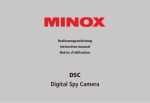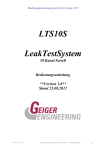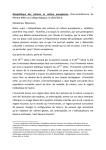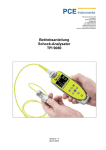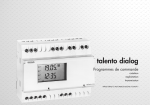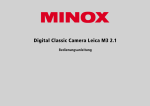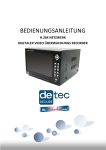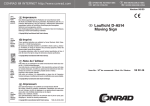Download Minox DCM 5.0 Instruction Manual
Transcript
DCM 5.0 DIGITAL CAMERA MODULE Bedienungsanleitung Instruction manual Notice d’utilisation Modus-Knopf Mode-button Bouton Mode Aufwärts-Knopf Up-button Bouton vers le haut Abwärts-Knopf Down-button Bouton vers le bas Auswahl-Knopf Select-button Bouton de sélection Auslöser Shutter-button Déclencheur Vergrößerungen mit dem DCM Magnifications with the DCM Grossissements avec le DCM Spektiv Spotting Scope Lunette terrestre Vergrößerung Magnification Grossissement Minox MD 62 Serie / Series / Série 40 x Leica Televid 62 32 x Leica Televid 77 40 x Swarovski AT / ST 80 42 x Swarovski ATS / STS 65 42 x Swarovski ATS / STS 80 42 x Kowa TSN 1-4 38 x Kowa TSN 600 Serie / Series / Série 38 x Kowa TSN 660 Serie / Series / Série 38 x Kowa TSN 820 Serie / Series / Série* 38 x Kowa TSN 770 Serie / Series / Série* 45 x Kowa TSN 880 Serie / Series / Série* 45 x Zeiss Diascope 65 35 x Andere Spektive sind mit dem MINOX DCM nicht kombinierbar. Other spotting scopes can not be adapted with the MINOX DCM. On ne peut pas combiner le MINOX DCM et d’autres lunettes terrestres. *benötigt den Kowa Okular-Adapter *requires Kowa eyepiece adapter *nécessite un adapteur de Kowa Bedienungsanleitung MINOX DCM Deutsch . . . . . . . . . . . . . . . . . . . . . . . . . . . . . . . . . . . . . . . . . . . . . ab Seite 2 Instruction manual MINOX DCM English . . . . . . . . . . . . . . . . . . . . . . . . . . . . . . . . . . . . . . . . . . . . from page 20 Notice d’utilisation MINOX DCM Français . . . . . . . . . . . . . . . . . . . . . . . . . . . . . . . . . . . . . . . . . . . . de page 36 Inhaltsverzeichnis Einleitung . . . . . . . . . . . . . . . . . . . . 3 Benutzen des Selbstauslösers . . . . . . . . . 10 Einsetzen der Batterie . . . . . . . . . . . . . . 3 Einstellen des Weißabgleichs (WB) . . . . . . 11 Aufladen der Batterie . . . . . . . . . . . . . . 4 Einstellen des Belichtungswertes (EV) . . . . 12 Einschalten der Kamera . . . . . . . . . . . . . 4 Anpassen Ihrer Kamera-Einstellungen . . . . 12 Ihr erstes Bild . . . . . . . . . . . . . . . . . . 5 Benutzen der Fernbedeinung . . . . . . . . . 14 Video-Aufnahme . . . . . . . . . . . . . . . . 5 Wartung des Kameramoduls . . . . . . . . . 15 Wiedergabe-Modus . . . . . . . . . . . . . . . 6 Technische Daten . . . . . . . . . . . . . . . 17 Bildqualität . . . . . . . . . . . . . . . . . . . 7 Gewährleistungsbestimmungen . . . . . . . 18 Erweiterung des Speicherplatzes durch eine SD-Karte . . . . . . . . . . . . . . . 8 Einsetzen einer SD-Karte . . . . . . . . . . . . 8 Löschen von Bildern . . . . . . . . . . . . . . . 9 Übertragen Ihrer Bilder auf Ihren Computer . . . . . . . . . . . . . . . 9 2 Einleitung Lernen Sie das DCM kennen Wir beglückwünschen Sie zum Kauf Ihres MINOX DCM. Wie alle anderen MINOX Produkte steht auch dieses digitale Kameramodul in der großen Tradition unseres Hauses. Es verbindet Funktionalität auf kleinstmöglichem Raum mit sehr guter optischer Qualität. Nehmen Sie sich bitte einige Momente Zeit, um diese Anweisungen und die Sicherheits- und Wartungshinweise im letzten Abschnitt dieser Bedienungsanleitung zu lesen. Einfach und schnell zu bedienen, ist das MINOX DCM für die digitale Beobachtung bzw. digitale Fotografie in Kombination mit einem Spektiv hervorragend geeignet. Das MINOX DCM kann zu Ihrem ständigen Begleiter werden, um Ihre schönsten Erinnerungen auf moderne Weise festzuhalten. Ihr Kameramodul verwendet eine wiederaufladbare Lithium-Ionen-Batterie. Die Batterie kann mithilfe des im Lieferumfang enthaltenen Zubehörs aufgeladen werden. Wir gewähren weder für die Batterie noch für das Kameramodul Garantie, falls die Batterie auf andere Art aufgeladen wird. Diese Anleitung soll Ihnen helfen, das Leistungsspektrum des MINOX DCM kennen zu lernen und optimal zu nutzen. Um die Batterie einzusetzen, halten Sie mit der rechten Hand das Kameramodul bei geöffneter Monitorabdeckung so, dass die Rückseite nach oben zeigt. Öffnen Sie jetzt die Batterieabdeckung, indem Sie mit dem Daumen der linken Hand den Verschluss öffnen und zur Seite ziehen. Wir wünschen Ihnen viel Freude beim Fotografieren! Einsetzen der Batterie 3 Schieben Sie die Batterie mit den Metall-Kontakten voran in das Batteriefach und schließen Sie die Batterie-Verriegelung. Schließen Sie das Batteriefach. Auch wenn die Batterie entfernt oder ersetzt wird, bleiben Ihre Bilder im Speicher der Kamera oder der SD-Karte gesichert. Aufladen der Batterie Schließen Sie das ausgeschaltete Kameramodul unter Verwendung des mitgelieferten USB-Kabels an den USB-Anschluss Ihres Computers an. Der Ladevorgang startet automatisch. Solange die Batterie geladen wird, leuchtet ein grünes Licht im Bereich des USB-Anschlusses. Wenn das Licht erlischt, ist der Ladevorgang abgeschlossen. Ein- / Ausschalten des Kameramoduls Um die Kamera einzuschalten, drücken und halten Sie die Modus-Knopf ON/MODE*. Um die Kamera auszuschalten, drücken Sie den Modus-Knopf so oft, bis das Einstellungs-Menü erscheint. Drücken Sie den Abwärts-Knopf, bis Ausschalten ausgewählt ist, und betätigen Sie dann den Auswahl-Knopf, um die Kamera auszuschalten. Batteriefach-Verriegelung 4 * siehe schematische Darstellung auf der Aufklappseite Einstellungen Ausschalten Formatieren Auto aus Frequenz In der Grundeinstellung schaltet sich Ihre Kamera automatisch aus, wenn sie 60 Sekunden nicht benutzt wird. Dies spart Batterie-Energie. Ihr erstes Bild Erfassen des Motivs Wird das DCM eingeschaltet, befindet es sich im Kamera-Modus; das -Symbol erscheint auf dem Display. Ist dieses Symbol nicht sichtbar, drücken Sie so oft auf den Modus-Knopf, bis es erscheint. Digitale Zoomfunktion Erfassen Sie das Motiv, das Sie aufnehmen wollen, im Display auf der Rückseite des Kameramoduls. Um den gewünschten Bildausschnitt in der Größe zu verändern (Zoom-Funktion), drücken Sie den Aufwärts- bzw. den Abwärtsknopf. Aufnahme des Bildes Drücken Sie den Auslöser (RELEASE), um das Bild aufzunehmen. Video-Aufnahme Auswählen des Video-Modus Drücken Sie im Foto-Modus den Auswahl-Knopf (SEL/OK); das Kamera-Menü erscheint. Wählen Sie mit Hilfe des Abwärtsknopfes die Option Video aus und drücken Sie dann erneut den Auswahl Knopf (SEL/OK), um in das Video-Einstellungen-Menü zu gelangen. Die Option Kamera ist ausgewählt. Wählen Sie mit Hilfe des Aufwärtssknopfes die Option Video aus und drücken Sie dann den Auswahl Knopf (SEL/OK), um die Einstellung zu bestätigen. Die Kamera befindet sich jetzt im Video-Modus, das -Symbol erscheint auf dem Display. 5 Erfassen der Szene Wiedergabe-Modus Erfassen Sie die Szene, die Sie aufnehmen möchten, mit dem Display auf der Rückseite der Kamera. Um den gewünschten Bildausschnitt in der Größe zu verändern (Zoom-Funktion), drücken Sie den Aufwärts- bzw. den Abwärtsknopf. Betrachten Sie Ihre Bilder und Videos auf dem Display Drücken Sie den Modus-Knopf (ON/MODE) so oft, bis Sie in den Wiedergabe-Modus ( ) gelangen. Aufnahme des Videos Drücken Sie den Aufwärts- bzw. Abwärts-Knopf, um durch die gespeicherten Bilder zu blättern. Drücken Sie den Auslöser, um die Aufnahme zu starten. Durch erneuten Druck auf den Auslöser beenden Sie die Aufnahme. Während der Aufnahme erscheint ein roter Punkt auf dem Display. Um die Wiedergabe eines Video-Clips zu starten drücken Sie den Auslöser. Drücken Sie erneut den Auslöser, um die Wiedergabe vor dem Ende des Clips anzuhalten. Kamera Video Qualität Video Video Kamera Selbstauslöser WB 6 Detail-Ansicht Sie können Detailausschnitte Ihrer Bilder mithilfe der Zoomfunktion genauer betrachten. Drücken Sie, während Sie ein Bild betrachten, den Auswahl-Knopf (SEL/OK), um in das WiedergabeMenü zu gelangen. Wählen Sie Zoom und drücken Sie erneut den Auswahl-Knopf (SEL/OK). Wiedergabe Wiedergabe Zoom Zoom 4 Miniaturbilder 4 Miniaturbilder 9 Miniaturbilder 9 Miniaturbilder Dia Show Dia Show Drücken Sie den Aufwärts- bzw. Abwärts-Knopf, um das Bild zu vergrößern bzw. zu verkleinern. Drücken Sie den Auswahl-Knopf zweimal, um den Zoom-Modus zu verlassen. Gleichzeitiges Betrachten mehrerer Bilder Drücken Sie im Wiedergabe-Modus ( ) den Auswahl-Knopf, um ins Wiedergabe-Menü zu gelangen, wählen Sie 4 Bilder oder 9 Bilder und drücken Sie den Auswahl-Knopf. Das Display zeigt nun 4 oder 9 Miniaturen Ihrer Bilder. Betrachten Ihrer Bilder in einer Dia-Show Ihr Kameramodul kann Ihre Bilder automatisch als Dia-Show nacheinander abspielen. Drücken Sie im Wiedergabe-Modus ( ) den Auswahl-Knopf, um ins Wiedergabe-Menü zu gelangen, wählen Sie Dia-Show und drücken Sie den AuswahlKnopf. Die Dia-Show wird gestartet. Um die Dia-Show anzuhalten, drücken Sie erneut den Auswahl-Knopf. Bildqualität Mit steigender Qualität wächst die Größe der einzelnen Bilddatei. Sie können zwischen drei verschiedenen Qualitätsstufen für Ihre Bilder wählen. Dadurch beeinflussen Sie, wieviele Bilder auf den internen Speicher des DCM passen: Wählen Sie ein bestimmtes Bild mithilfe des Aufwärts- bzw. des Abwärts-Knopfes und drücken Sie den Auswahl-Knopf, um es zu vergrößern. 7 Kamera Qualität Qualität Niedrig Video Normal Selbstauslöser Hoch WB Niedrig (*) - 2048 x 1536 Pixel – bis zu 117 Bilder Normal (**) - 2048 x 1536 Pixel – bis zu 60 Bilder Hoch (***) - 2560 x 1920 Pixel (durch Interpolation) – bis zu 37 Bilder Drücken Sie im Kamera-Modus den AuswahlKnopf (SEL/OK); Sie gelangen ins Kamera-Menü. Wählen Sie Qualität und drücken Sie erneut den Auswahl-Knopf (SEL/OK). Sie gelangen ins Qualitäts-Menü, wo Sie mithilfe des Aufwärts- bzw. Abwärts-Knopfes zwischen den verschiedenen Qualitätsstufen wählen können. 8 Drücken Sie erneut den Auswahl-Knopf (SEL/OK), um Ihre Wahl zu bestätigen. Erweiterung des Speicherplatzes durch eine SD-Karte SD-Karten (Secure Digital) erweitern den Speicherplatz, der Ihrem Kameramodul für die Speicherung von Bildern und Videos zur Verfügung steht. SDKarten erhalten Sie in Fotofachgeschäften und im Elektronikhandel. Ihre Kamera unterstützt bis zu 4 GB SD-Karten-Speicher. Einsetzen einer SD-Karte Öffnen Sie das Batteriefach und setzen Sie die SDKarte mit zum Display zeigenden Gold-kontakten in den SD-Karten-Steckplatz ein. Wichtig: Wenn die SD-Karte schreibgeschützt ist, erscheint ein Schloss-Symbol auf dem Display und es können keine Fotos oder Videos aufgenommen werden. Löschen von Bildern Löschen eines einzelnen Bildes Wählen Sie im Wiedergabe-Modus ( ) mithilfe des Aufwärts- bzw. des Abwärtknopfes das Bild, das Sie löschen möchten. Drücken Sie den Auswahl-Knopf (SEL/OK), um ins Wiedergabe-Menü zu gelangen, wählen Sie Bild löschen und drücken Sie den Auswahl-Knopf. Wählen Sie Ja und drücken Sie erneut den Auswahl-Knopf (SEL/OK). Das ausgewählte Bild wird aus dem Speicher der Kamera gelöscht. Löschen aller Bilder Drücken Sie im Wiedergabe-Modus ( ) den Auswahl-Knopf, um ins Wiedergabe-Menü zu gelangen, wählen Sie Alle löschen und drücken Sie den Auswahl-Knopf (SEL/OK). Wählen Sie Ja und drücken Sie erneut den Auswahl-Knopf. Alle Bilder werden aus dem Speicher der Kamera gelöscht. Übertragen Ihrer Bilder auf Ihren Computer Hinweis: Sie müssen keine Kamera-Treiber installieren für die Windows-Versionen Vista/2000/ME/ XP oder Mac OS 9+ oder OS X. Ihre MINOX DCM unterstützt keine älteren Versionen der oben genannten Betriebssysteme. Hinweis: Wenn Ihr DCM angeschlossen ist, wird es über das USB-Kabel vom Computer mit Strom versorgt, wodurch die Energiereserven der Batterie geschont werden. Anschließen Ihrer Kameramoduls an den Computer Bevor Sie Ihr Kameramodul an den Computer anschließen, schalten Sie es immer zuvor ein. Schließen Sie dann Ihr DCM mithilfe des mitgelieferten USB-Kabels an den Computer an. (Der kleinere Stecker wird am Kameramodul und der größere an den Computer angeschlossen.) 9 Wenn Sie Ihr Kameramodul zum ersten Mal an Ihren Computer anschließen, erkennt Ihr Computer es als eine neue Hardware. Ihr Computer installiert die Treiber automatisch. Warten Sie, bis Ihr Computer Sie über den Abschluss der Installation informiert, bevor Sie versuchen, Zugang zu den auf dem Kameramodul oder der SD-Karte gespeicherten Bildern oder Filmen zu erhalten. Übertragen der Bilder auf einen Windows PC Öffnen Sie das Mein Computer-Symbol auf Ihrem Computer. Sie sehen ein Symbol mit der Bezeichnung Wechseldatenträger. tensymbol mit der Bezeichnung Unbenannt auf Ihrem Desktop. Innerhalb dieser Festplatte finden Sie einen Ordner DCIM und darin wiederum einen Ordner 100_CAM, in dem sich alle Ihre Bilder befinden. Sie können die Festplatte Unbenannt in jeden gewünschten Namen umbenennen. Hinweis: Sie können Ihre Kamera auch für das Speichern oder Übertragen von anderen Dateien nutzen. Öffnen Sie hierzu den oben genannten Ordner und kopieren Sie die entsprechende Datei in diesen Ordner, um sie auf dem Kamera-Speicher zu sichern. Doppelklicken Sie auf das Symbol und öffnen Sie den Ordner DCIM und dann den Ordner 100_CAM, in dem sich alle Ihre Bilder befinden. Benutzen des Selbstauslösers Übertragen der Bilder auf einen Apple Mac Drücken Sie im Kamera-Modus den AuswahlKnopf (SEL/OK); Sie gelangen ins Kamera-Menü. Wählen Sie Selbstauslöser und drücken Sie erneut Nachdem Sie die Kamera angeschlossen und eingeschaltet haben, erscheint ein neues Festplat10 Fotografieren oder filmen Sie sich selbst, indem Sie die Selbstauslöser-Funktion nutzen. Kamera Selbstauslöser Qualität An Video Aus Selbstauslöser WB den Auswahl-Knopf (SEL/OK). Sie gelangen in das Selbstauslöser-Menü. Wählen Sie An und drücken Sie den Auswahl-Knopf (SEL/OK), um Ihre Eingabe zu bestätigen. Das Kameramodul ist jetzt im Selbstauslöser-Modus, das -Symbol erscheint im Display. Erfassen Sie Ihr Bild nach Belieben. Die Zoom-Funktion steht Ihnen wie gewohnt zur Verfügung. Nach Betätigen des Auslösers dauert es zwei Sekunden, bis das Bild aufgenommen wird. gegeben werden. Das Kameramodul ist ab Werk auf automatischen Weißabgleich eingestellt. Bei kritischen Lichtverhältnissen können Sie den Weißabgleich gezielt anpassen. Drücken Sie im Kamera-Modus den Auswahl-Knopf (SEL/OK); Sie gelangen ins Kamera-Menü. Wählen Sie WB und drücken Sie erneut den Auswahl-Knopf (SEL/OK). Im WB-Menü können Sie zwischen 6 Einstellungen wählen: Auto (automatisch), Tageslicht, Bewölkt, Glühbirne, Kunstlicht, Nacht Drücken Sie den Auswahl-Knopf (SEL/OK), um Ihre Wahl zu bestätigen. Kamera WB Qualität Auto Einstellen des Weißabgleichs (WB) Video Tageslicht Durch den Weißabgleich wird sichergestellt, dass die Farben in Ihren Bildern naturgetreu wieder- Selbstauslöser Bewölkt WB Glühbirne 11 Einstellen des Belichtungswertes (EV) Anpassen Ihrer Kamera-Einstellungen In kritischen Lichtverhältnissen können Sie die Helligkeit Ihrer Aufnahmen manuell regulieren. Öffnen des Einstellungen-Menüs Drücken Sie im Kamera-Modus den Auswahl-Knopf (SEL/OK); Sie gelangen ins Kamera-Menü. Wählen Sie EV und drücken Sie erneut den Auswahl-Knopf (SEL/OK). Reduzieren oder erhöhen Sie jetzt die Belichtungszeit mithilfe des Aufwärts- bzw. des Abwärts-Knopfes. Drücken Sie den Auswahl-Knopf (SEL/OK), um Ihre Eingabe zu bestätigen. EV 12 Wählen Sie mithilfe des Aufwärts- bzw. des Abwärts-Knopfes eine der folgenden Optionen: Einstellungen Ausschalten Formatieren Auto aus Frequenz Kamera Verlassen Drücken Sie den ON/MODE Knopf, bis das Einstellungen-Menü auf dem Display erscheint. Ausschalten EV +0.3 Wählen Sie Ausschalten und drücken Sie den Auswahl-Knopf (SEL/OK), um das Kameramodul auszuschalten. Formatieren Zurücksetzen der Einstellungen Es ist möglich, den Speicher der Kamera zu formatieren. Wählen Sie im Einstellungen-Menü Formatieren und drücken Sie den Auswahl-Knopf. Wählen Sie im Formatieren-Menü Ja und drücken Sie erneut den Auswahl-Knopf (SEL/OK). Sämtliche Bilder und Einstellungen werden gelöscht. Wenn Sie die Einstellungen Ihrer Kamera auf die Einstellungen ab Werk zurücksetzen möchten, wählen Sie Einstellung und drücken Sie den Auswahl-Knopf (SEL/OK). Wählen Sie Voreinstellung und drücken Sie den Auswahl-Knopf, um die Einstellungen zurückzusetzen. Einstellen der AutoAus-Zeit Wahl der Sprache Wählen Sie AutoAus und drücken Sie den AuswahlKnopf (SEL/OK). Wählen Sie, nach welchem Zeitraum sich die Kamera automatisch abschaltet. Sie können die Sprache für die Menüs einstellen. Wählen Sie Sprache und drücken Sie den AuswahlKnopf (SEL/OK). Anpassen der Frequenz Wählen Sie Ihre bevorzugte Sprache und bestätigen Sie Ihre Eingabe mit dem Auswahl-Knopf (SEL/OK). Um bei Kunstlichtaufnahmen im Video-Modus Bildflackern zu reduzieren, können Sie die Frequenz manuell anpassen. Wählen Sie Frequenz und drücken Sie den Auswahl-Knopf (SEL/OK). Wählen Sie zwischen 50 Hz und 60 Hz und bestätigen Sie Ihre Eingabe mit dem Auswahl-Knopf. 13 Benutzen der Fernbedienung Zoomfunktion Die Ferdnbedinung des DCM hat eine Reichweite von ca. zwei Metern. Drücken Sie an der flachen Seite der DCM Fernbedienung den Zoom Knopf. Auslösen eines Bildes Drücken Sie den großen Knopf mit dem KameraSymbol um ein Bild zu machen. Batteriewechsel Öffnen Sie die Batterieklappe – folgen Sie hierbei den Richtungspfeilen. Fügen Sie eine neue CR2032 Batterie in den dafür vorgesehen Platzhalter ein. Achten Sie hierbei auf die Polarität. Schließen Sie nun wieder das Batteriefach. Videofunktion Drücken Sie an der flachen Seite der DCM Fernbedienung den MODUS P/V. Nun startet das Video. Ein erneuter Druck auf diesen Knopf stoppt das Video. 14 Wartung des MINOX DCM Bitte lesen Sie die folgenden Informationen, um sicherzustellen, dass Sie Ihr DCM korrekt benutzen. Orte, die Sie meiden sollten Lagern oder benutzen Sie die Kamera nicht in folgender Umgebung: • An sehr feuchten, schmutzigen oder staubigen Orten. • An Orten mit direkter Sonneneinstrahlung oder extremen Temperaturen, wie zum Beispiel in einem geschlossenen Auto im Sommer. • An extrem kalten Orten. • An Orten, die starken Vibrationen ausgesetzt sind. • An Orten, die Rauch oder Dampf ausgesetzt sind. • An Orten, die starken Magnetfeldern ausgesetzt sind (zum Beispiel nahe Elektromotoren, Transformern oder Magneten). • An Orten, an denen über längere Zeiträume aggressive Chemikalien wie Pestizide, Gummi- oder Vinylprodukte gelagert werden. Hinweis: Halten Sie das DCM von Sand und Staub fern. Wie jede elektronische Kamera ist auch das DCM besonders empfindlich gegen Sand und Staub. Stellen Sie bitte in sandigen Gegenden, besonders an Stränden oder Wüsten, wo feiner Sand durch Wind aufgewirbelt wird, sicher, dass das Kameramodul dem Sand nicht ausgesetzt ist. Aufbewahrung des Kameramoduls Wenn Ihr DCM für einen längeren Zeitraum nicht benutzt wird, entfernen Sie bitte die Batterie und lagern Sie das Kameramodul am besten an einem trockenen Ort. Reinigung Ihres DCM Benutzen Sie einen kleinen Pinsel, um vorsichtig den Staub von Linse und der LCD-Oberfläche zu entfernen. 15 Wischen Sie die Oberfläche leicht mit einem trockenen, weichen und fusselfreien Tuch ab. Sollten auf dem Objektiv irgendwelche Flecken entstanden sein, geben Sie einen Tropfen flüssigen Linsenreiniger auf ein Optiktuch und wischen Sie die Linsenoberfläche sachte ab. Kratzen Sie über keinen Teil des Kameramoduls mit harten Gegenständen. Benutzen Sie keine flüchtigen Substanzen wie Verdünner, Benzol oder Insektizide, denn sie könnten mit dem Kameragehäuse reagieren und eine Verformung zur Folge haben oder die Beschichtung zerstören. Bei Flugreisen Verstauen Sie Ihr Kameramodul nicht im normalen Reisegepäck. Der Umgang mit dem Gepäck an Flughäfen könnte sie im Inneren beschädigen, selbst wenn von außen keine Einflüsse sichtbar sind. 16 Technische Daten Bildsensor 5,0 MP, CMOS Sensor (3,2 MP Hardware-Auflösung) Bildauflösung Standbild: 2.560 x 1.920 Pixel (Interpoliert), 2.048 x 1.536 Pixel (3,2 MP); Videoclip: 320 x 240 Pixel Speichermedien Intern: 128 MB Flash Memory / Extern: optionale SD Karte bis 16 GB (unterstützt SDHC) Display 2,0’’ TFT-LCD Monitor Weißabgleich Automatisch, Tageslicht, Bewölkt, Glühbirne, Kunstlicht, Nacht Auslöser Direkt / Fernbedienung / Selbstauslöser: 2 Sekunden Zoom 4-fach Digitalzoom Aufzeichnung Standbild: JPEG / Videoclips: AVI Energieversorgung Aufladbarer Li-Ionen Akku / USB-Kabel Systemvorraussetzungen Windows Vista / ME / 2000 / XP; Mac OS X kompatibel Abmessungen 74 mm x 47 mm x 44 mm (B x H x T) Gewicht ca. 220 g 17 Gewährleistungsbestimmungen Mit dem Kauf des MINOX DCM haben Sie ein Produkt erworben, das nach besonders strengen Qualitätsrichtlinien hergestellt und geprüft wurde. Die für dieses Produkt geltende gesetzliche Gewährleistung von 2 Jahren wird von uns ab dem Tag des Verkaufs durch einen autorisierten Händler unter folgenden Bedingungen übernommen: 1) In der Gewährleistungszeit werden Beanstandungen, die auf Fabrikationsfehlern beruhen, kostenlos und nach eigenem Ermessen durch Instandsetzung, Austausch defekter Teile oder Umtausch in ein gleichartiges einwandfreies Erzeugnis behoben. Weitergehende Ansprüche, gleich welcher Art und gleich aus welchem Rechtsgrund im Zusammenhang mit dieser Gewährleistung, sind ausgeschlossen. 18 2) Gewährleistungsansprüche entfallen, wenn der betreffende Mangel auf unsachgemäße Behandlung – wozu auch die Verwendung von Fremdzubehör zählen kann – zurückzuführen ist, ein Eingriff von nicht autorisierten Personen und Werkstätten durchgeführt oder die Fabrikationsnummer unkenntlich gemacht wurde. 3) Gewährleistungsansprüche können nur bei Vorlage eines maschinengeschriebenen Kaufbelegs eines autorisierten Händlers geltend gemacht werden. 4) Bei Inanspruchnahme der Gewährleistung leiten Sie bitte die MINOX Kamera zusammen mit dem Original des maschinengeschriebenen Kaufbelegs und einer Schilderung der Beanstandung dem Kundendienst der MINOX GmbH oder einer Landesvertretung zu. 5) Touristen steht im Bedarfsfalle unter Vorlage des maschinengeschriebenen Kaufbelegs die Vertretung des jeweiligen Reiselandes gemäß den Regelungen zur Gewährleistung der MINOX GmbH zur Verfügung. MINOX GmbH Walter-Zapp-Str. 4 D-35578 Wetzlar Tel.: +49 (0) 6441 / 917-0 Fax: +49 (0) 6441 / 917-612 eMail: [email protected] Internet: www.minox.com 19 Content Introduction . . . . . . . . . . . . . . . . . . 21 Using the Self Timer . . . . . . . . . . . . . . 28 Inserting the battery . . . . . . . . . . . . . 21 Adjusting the white balance (WB) . . . . . . 29 Charging the battery . . . . . . . . . . . . . 22 Adjusting the Exposure Values (EV) . . . . . 29 Switching the camera on . . . . . . . . . . . 22 Adjusting your camera settings . . . . . . . . 30 Taking your first picture . . . . . . . . . . . . 23 How to use the remote control . . . . . . . . 31 Taking videos . . . . . . . . . . . . . . . . . 23 Camera maintenance . . . . . . . . . . . . . 32 Playback mode . . . . . . . . . . . . . . . . 24 Technical Data . . . . . . . . . . . . . . . . . 34 Image quality . . . . . . . . . . . . . . . . . 25 Conditions of warranty . . . . . . . . . . . . 35 Increase the camera memory with an SD card . . . . . . . . . . . . . . . . 26 Inserting an SD card . . . . . . . . . . . . . . 26 Deleting unwanted images . . . . . . . . . . 26 Downloading your images to your computer . . . . . . . . . . . . . . . 27 20 Introduction Introducing your DCM Congratulations on the purchase of your new MINOX DCM. Like all other MINOX products this digital Camera Module boasts the traditional values fostered by MINOX. It combines functionality in the smallest possible space with excellent optical quality. Please take a few moments to read these Instructions and the Safety and Maintenance notes in the last section of this manual. Fast and easy operation make the MINOX DCM an excellent tool for digital observation and digital photography in combination with a spotting scope. The MINOX DCM is ready to become your permanent companion and capture wonderful memories in the modern way. These instructions are to help you benefit from the full performance spectrum of your MINOX DCM. Enjoy photography with your digital Camera Module! Inserting the battery Your camera uses a lithium-ion rechargeable battery. You can recharge the battery using the provided accessory equipment. We do not warranty for battery or camera damage caused by using any other method to charge the battery. To insert the battery hold the Camera Module with your right hand, with the monitor shield flipped open and the back facing upward. Now open the battery compartment cover by opening the latch with the thumb of your left hand and moving it to the side. 21 Slide the battery into the battery compartment with the metal contacts head first and close the battery latch. Close the battery compartment. Your photos will remain safely stored in the camera memory or on the SD card even if the batteries are removed or replaced. Charging the battery Connect the switched off Camera Module using the provided USB cable to the USB connection of your computer. This starts the charging process automatically. While the battery is being charged a green lamp lights up in the proximity of the USB connection. Charging is completed when the lamp extinguishes. Switching your Camera Module On / Off To switch the camera on press and hold the Mode button ON/MODE. To switch your camera off, press the Mode button until the Setup menu appears. Press the Down button until Power Off is selected and then press the Select button to switch the camera off. By default the DCM will automatically switch itself off if it is not used within 60 seconds, thus saving battery power. Battery lock 22 * see schematic diagram on the flipped-open side. Setup Power Off Format Auto Off Frequency Shoot the picture Press the shutter button (RELEASE) to shoot the picture. Taking videos Select Video Mode Taking your fi rst picture Frame your subject When the DCM is switched on it is in Camera Mode and the symbol appears on the display. If this symbol does not show, press the Mode button until it appears. Digital zoom function Frame your subject in the display on the back of the Camera Module. In the Photo mode, press the Select button (SEL/ OK); the Camera Menu appears. Use the Down button to select the option Movie and then press the Select button (SEL/OK) again to get into the Video Setup Menu. The Camera option is selected. Use the Up button to select the option Movie and then press the Select button (SEL/OK) to confirm the setting. The camera is now in Video Mode, the symbol will show on the display. To change the size of the desired image detail (zoom function) press the Up button (to zoom in) or Down button (to zoom out). 23 Frame the scene Playback mode Frame the scene you want to take using the display on the back of the camera. To change the size of the desired image detail (zoom function) press the Up button (to zoom in) or the Down button (to zoom out). Review your pictures and videos on the display Shoot the video Press the shutter button to start the replay of a video clip. Press the shutter button again to stop the replay before the end of the clip. Press the shutter button (RELEASE) to start the recording. Press it again to stop the video. During the shooting you will see a red dot in the display. Camera Movie Quality Movie Movie Camera Self Timer WB Press the Mode button (ON/MODE) as many times as needed to get into the Playback mode ( ). Use the Up or Down button to scroll through the stored images. Look at details You can take a closer look at details of your images using the zoom function. Press the Select button (SEL/OK) while viewing an image. Select Zoom and press the Select button (SEL/OK) again. Press the Up or Down button to zoom in or zoom out. Press the Select button twice to leave Zoom Mode. 24 Playback Playback Zoom Zoom 4 Thumbnail 4 Thumbnail 9 Thumbnail 9 Thumbnail Slide Show Slide Show Review several images at once Press the Select button when in Playback Mode ( ) to reach the Playback Menu, select either 4 or 9 images, and press the Select button. The display will now show 4 or 9 miniature images of your pictures. Select one of the images using the Up or Down button and press the Select button to enlarge this image. View your pictures in a slide show Your Camera Module can automatically display your images one after the other in a slide show. Press the Select button when in Playback Mode ( ) to reach the Playback Menu, select Slide Show and press the Select button. The slide show then starts. Press the select button again to stop the slide show. Image quality The higher the selected quality, the larger the size of the individual image file. You can choose between three different quality settings for your images. This has an impact on the number of images that will fit on the internal memory of the DCM: Low (*) - 2048 x 1536 pixels – up to 117 images Normal (**) - 2048 x 1536 pixels – up to 60 images High (***) - 2560 x 1920 pixels (by interpolation) – up to 37 images 25 Camera Quality Quality Low Movie Normal Self Timer High WB When in Camera Mode press the Select button (SEL/OK) to enter the Camera Menu. Select Quality and press the Select button (SEL/OK) again. This brings you into the Quality Menu where you can select the different quality settings using the Up or Down button. Press the Select button (SEL/OK) again to confirm your selection. Increase memory capacity with an SD Card SD Cards (Secure Digital) increase the amount of memory available for storing images and videos. SD cards can be purchased from photo dealers and 26 from electronic goods retailers. Your camera supports up to 4 GB SD Card memory. Inserting an SD Card Open the battery compartment and insert the SD card in the SD Card slot with the gold contacts pointing to the Display. Important: If the SD Card is write-protected, a lock symbol appears on the display and you cannot shoot pictures or videos. Deleting unwanted images Delete an individual image In Playback Mode ( ) use the Up or Down button to select the image you want to delete. Press the Select button (SEL/OK), to enter the Playback Menu, select Delete One and press the Select button. Select Yes and press the Select button (SEL/OK) again. The selected image is then deleted from the camera memory. Delete all images In Playback mode ( ) press the Select button to enter the Playback Menu, select Delete All and press the Select button (SEL/OK). Select Yes and press the Select button (SEL/OK) again. All images are then deleted from the camera memory. Downloading pictures onto your computer Note: You do not need to install camera drivers for Windows versions Vista/2000/ME/XP or Mac OS 9+ or OS X. Your MINOX DCM does not support older versions of the named operating systems. Note: When your DCM is connected your computer supplies the power via the USB cable to save the batteries. Connect your Camera Module to the computer Always turn your Camera Module on before connecting it to the computer. Then connect the DCM to the computer using the provided USB cable (the smaller sized head connects to the Camera Module and the larger one to the computer). When you connect your Camera Module to your computer for the first time, your computer will recognize it as new hardware. Your computer then installs the drivers automatically. Wait until your computer informs you that the installation is complete before trying to access the pictures or movies stored in the camera or on the SD card. Download images to a Windows PC Open the My Computer icon on your computer. You will see a new icon named Removable Disk. Double click on the icon and open the folder DCIM and then the folder 100_CAM in which all of your images are stored. 27 Download images to an Apple Mac After connecting the Camera Module and switching it on, a new hard disk icon appears on your Desktop called Untitled. In this hard disk you will find a folder named DCIM and this contains a folder named 100_CAM in which all of your images are stored. You can rename Untitled to any name you prefer. Note: You can also use your Camera Module for saving or transferring other files. Simply open the above named folder and copy in the file you want to save in the camera memory. Using the Self Timer Put yourself in the picture using the Self Timer function. The timer has a two seconds delay. In Camera Mode press the Select button (SEL/OK); This provides access to the Camera Menu. Select Self Timer and press the Select button (SEL/OK) 28 again. This provides access to the Self Timer Menu. Select On and press the Select button (SEL/OK) to confirm your selection. The Camera Module is now in Self Timer Mode, the symbol appears on the display. Frame your picture as required. To do this, you can still use the zoom function as normal. After pressing the shutter button you have two seconds to put yourself in the picture before the shutter is released. Camera Self Timer Quality On Movie Off Self Timer WB Adjusting the White Balance (WB) Adjusting the Exposure Values (EV) The white balance ensures natural color rendition of your pictures. The Camera Module is set to automatic white balance in the factory. In critical light conditions you can selectively adjust the white balance. In critical light conditions you can manually adjust the brightness of your images. In Camera Mode press the Select button (SEL/OK); this provides access to the Camera Menu. Select WB and press the Select button (SEL/OK) again. In the WB Menu you can choose between 6 settings: Auto (automatic), Daylight, Cloudy, Lamp, Tungsten, Night Press the Select button (SEL/OK) to confirm your selection. In Camera Mode press the Select button (SEL/OK); this provides access to the Camera Menu. Select EV and press the Select button (SEL/OK) again. Now reduce or increase the exposure time using the Up or Down button. Press the Select button (SEL/OK) to confirm your adjustment. Camera EV Exit Camera WB Quality Auto Movie Daylight Self Timer Cloudy WB Lamp EV + 0.3 29 Adjusting your camera settings Formatting Open the Setup Menu It is possible to format your camera memory. In the Setup Menu select Format and press the Select button. Select Yes in the Formatting Menu and press the Select button (SEL/OK) again. This deletes all images and settings. Press the ON/MODE button until the Setup Menu appears on the display. Setup Power Off Set AutoOff time Format Select AutoOff and press the Select button (SEL/ OK). Select the time after which you would like the camera to switch off automatically if left unattended. Auto Off Frequency Use the Up or Down button to select one of the following options: Switch off Select the option Power Off and press the Select button (SEL/OK) to switch off the Camera Module. Adjust frequency You can manually adjust the frequency to reduce image flicker under tungsten light when in the Video Mode. Select Frequency and press the Select button (SEL/OK). Select between 50 Hz and 60 Hz and confirm your setting with the Select button. 30 Reset settings If you want to reset the camera settings to the default settings select Settings and press the Select button (SEL/OK). Select Default and press the Select button to reset the settings. Language setting You can set the language used in the menus. Select Language and press the Select button (SEL/OK). Select the preferred language and confirm the setting with the Select button (SEL/OK). How to use the remote control Capturing video Press the MODUS P/V button to start capturing video and press this button again to stop capturing. Zooming in/out Press the Zoom button to zoom in/out. The remote can release the shutter of the DCM within the range of two meters. Capturing image Press the big round button at the front with the camera symbol to capture image. Insert & change battery Follow the direction on a battery compartment cover to open. Take a new CR2032 battery and 31 temperatures, such as the inside of a closed car in the summer, • extremely cold places, • places exposed to severe vibrations, • places exposed to smoke or steam, place it in the battery compartment. Pay attention to the correct pole alignment +/-. Close and lock the battery compartment cover. • places exposed to strong magnetic fields (e.g. in close proximity of electric motors, transformers or magnets, Maintenance of the Camera Module • places where aggressive chemicals are stored on a long-term basis, such as pesticides, rubber or vinyl products. Please read the following information to make sure you are using your DCM correctly. Places to avoid Do not store or use your camera in any of the following environments: • very damp, dirty or dusty places, • places exposed to direct sunlight or extreme 32 Note: Always keep the DCM away from sand and dust. Like any other electronic/digital camera, the DCM is particularly sensitive to sand and dust. Always make sure that the camera is not exposed to sand in sandy places, especially on the beach or in the desert where fine sand is blown about. Storing the Camera Module Traveling by air If your DCM is not being used for a longer period, it is best to remove the battery and store the Camera Module in a dry place. Do not pack the Camera Module in baggage to be handed in at the airport. The baggage handling could cause damage on the inside of the Camera Module, even if there are no signs of this showing on the outside. Cleaning your DCM Use a small brush to carefully remove the dust from the lens and the LCD surface. Gently wipe the surface with a dry, soft, fluff-free cloth. If there are any spots on the lens, apply a few drops of liquid lens cleaner to an optical cloth and carefully wipe the lens surface. Never scratch any part of the Camera Module using a hard object. Do not use volatile substances like solvents, benzole or insecticide as these could react with the camera body and lead to deformation or destroy the coating. 33 Technical Data Image sensor 5.0 MP, CMOS Sensor (3.2 MP Hardware-resolution) Image resolution Still: 2,560 x 1,920 pixels (interpolated), 2,048 x 1,536 Pixel (3.2 MP); Videoclip: 320 x 240 pixels Memory Internal: 128 MB Flash memory External: optional SD card up to 16 GB (supports SDHC) Display 2.0’’ TFT LCD display White balance Automatic, Daylight, Cloudy, Lamp, Tungsten, Night Shutter Direct / Remote Control / Selftimer: 2 sec Zoom 4x digital zoom File-format Picture: JPEG / Video: AVI Power supply Rechargeable Lithium-Ion-Battery/USB-cable Support Windows Vista / ME / 2000 / XP; Mac OS X compatible Dimensions 74 mm (L) x 47 mm (W) x 44 mm (H) Weight approx. 220 g / 7.76 oz 34 Conditions of warranty With the purchase of this MINOX product you have acquired a product which has been manufactured and checked to special quality standards. For this product the MINOX GmbH provides warranty of 2 years. The period commences on the date of purchase from an authorized dealer and the warranty is subject to the following conditions: 1) During the warranty period we shall deal with complaints based on faulty manufacture (free of charge) by repair, replacement of defective parts or replacement by an identical flawless product at our own discretion. Consequential claims, no matter what kind of what legal argument in connection with this warranty, cannot be accepted. accessories – if the MINOX product is serviced by unauthorized persons or workshops, or if the serial number has been obliterated. 3) Warranty claims can only be made by submission of the typewritten sales slip of an authorized dealer. 4) When submitting claims under warranty please return the MINOX product together with the typewritten sales slip and a description of the claim to the MINOX GmbH or MINOX agency. 5) Tourists may, if required, make use of the Agency of the country in which they are travelling (within the terms of the Warranty of the MINOX GmbH) by presenting the typewritten sales slip. 2) Claims under warranty are null and void, if the defect has been caused by improper handling – which also can include the use of non-MINOX 35 MINOX GmbH Walter-Zapp-Str. 4 D-35578 Wetzlar Tel.: +49 (0) 6441 / 917-0 Fax: +49 (0) 6441 / 917-612 eMail: [email protected] Internet: www.minox.com 36 Notes 37 Sommaire Présentation . . . . . . . . . . . . . . . Installation de l’accu . . . . . . . . . . Chargement de l’accu . . . . . . . . . . Mise en marche de l’appareil . . . . . . Votre première photo . . . . . . . . . . Prise de vue en vidéo . . . . . . . . . . Mode Playback . . . . . . . . . . . . . La qualité des images . . . . . . . . . . Augmentez la mémoire de votre appareil avec une carte SD . . . . . . . Installation d’une carte SD . . . . . . . Effacement d’images . . . . . . . . . . Télécharger vos images sur votre ordinateur . . . . . . . . . . . Utilisation du retardateur . . . . . . . . Réglage de la balance des blancs (WB) . 38 . . . . . . . . . . . . . . . . . . . . . . . . 39 39 40 40 41 41 42 43 . . . 44 . . . 44 . . . 44 . . . 45 . . . 46 . . . 46 Compensation des valeurs d’exposition (EV) . . . . . . . . . Ajustement des réglages de votre appareil photo . . . . . . . . . . . Utilisation de la télécommande . . Maintenance de l'appareil . . . . Informations techniques . . . . . Clauses de la garantie . . . . . . . . . . . . . 47 . . . . . . . . . . . . . . . . . . . . . . . . . . . . . . 48 49 50 52 53 Présentation Nous vous félicitons pour l’acquisition de votre MINOX DCM. Comme tous les autres produits MINOX, ce module photo digital s’inscrit dans la longue tradition de notre maison: combiner fonctionnalité et qualité optique hors pair dans un espace aussi réduit que possible. Facile à commander, rapide à réagir, le MINOX DCM est idéal pour l’observation et la photographie digitales en combinaison avec une lunette terrestre. Le MINOX DCM deviendra vite indispensable lorsqu’il s’agira d’immortaliser vos plus beaux souvenirs, sous l’égide d’une technique moderne. Ce mode d’emploi vous aidera à connaître l’éventail des possibilités offertes par le MINOX DCM, en vue de leur exploitation optimale. Nous vous souhaitons de bonnes prises de vues ! Faites connaissance avec votre DCM Avant d’utiliser votre appareil, veuillez prendre le temps de lire les informations qui suivent, ainsi que les conseils d’utilisation et d’entretien présentés à la fin de ce mode d’emploi. Installation de l’accu Votre appareil photo est alimenté par un accu lithium-ion rechargeable à l’aide de l’accessoire fourni avec l’appareil. La recharge de cet accu par un autre moyen conduirait à l’annulation de la garantie, à la fois pour l’appareil et l’accu. Pour installer ce dernier, tenez le module photo dans la main droite avec le couvercle du moniteur ouvert, le dos dirigé vers le haut. Avec le pouce de la main gauche, déverrouillez le couvercle du logement de l’accu et ouvrez-le complètement. Poussez l’accu dans son logement avec les contacts métalliques dirigés vers l’avant. Bloquez-y l’accu en tournant 39 le petit levier de blocage puis refermez le couvercle du compartiment. Que ce soit lors de l’absence de l’accu ou de son remplacement, les prises de vue stockées dans la mémoire de l’appareil photo ou sur la carte SD restent préservées. Chargement de l’accu Connectez le module photo – hors tension – au port USB de votre ordinateur avec le câble USB fourni avec l’appareil. Le chargement commence automatiquement. Pendant la durée de ce processus, un témoin vert reste allumé au niveau de la connexion USB. Lorsqu’il s’éteint, le chargement est terminé. Mise sous/hors tension du module photo Verrou de l’accu 40 Pour mettre l’appareil photo sous tension, appuyer sur le bouton ON/MODE* en maintenant la pression. Pour le mettre hors tension, pressez sur ce même bouton jusqu’à apparition du menu RÉGLAGE. Avec les boutons vers le BAS/HAUT, sélectionnez Eteindre. Une simple pression sur le bouton de sélection SEL/OK mettra votre appareil hors tension. Afin d’économiser l’énergie de son accu, l’appareil se met automatiquement hors tension s’il reste inutilisé 60 secondes. * voir à ce sujet la représentation schématique sur la page rabattable Réglage Eteindre Format Arrêt automat. Fréquence La prise de vue Pressez sur le déclencheur (RELEASE) pour prendre votre photo. Prise de vue en vidéo Sélection du mode vidéo Votre première photo Sélection du motif Lors de sa mise sous tension, le DCM se trouve en MODE PHOTO et le symbole apparaît sur l’écran du moniteur. Si ça n’est pas le cas, pressez sur le bouton ON/MODE jusqu’à son affichage. La fonction ZOOM DIGITAL Sélectionner votre motif à l’aide de l’écran du moniteur (au dos du module photo). Pour changer la taille du cadrage choisi (Fonction ZOOM), presser sur les boutons vers le HAUT/BAS. À partir du MODE PHOTO, pressez sur le bouton de sélection SEL/OK pour accéder au menu APPAREIL. Avec les boutons HAUT/BAS, sélectionnez Film (option video). Confirmez via SEL/OK pour accéder au menu FILM où vous élisez l’option Film. Confirmez avec SEL/OK. Votre appareil se trouve maintenant en mode VIDEO: Le symbole s’affiche sur l’écran du moniteur. Préparation d’une scène Appréhendez la scène que vous voulez filmer à l’aide de l’écran du moniteur (au dos de l’appareil). Pour modifier la taille du cadrage (fonction ZOOM), pressez sur les boutons HAUT ou BAS. 41 Appareil Film Qualité Film Film Appareil Retardateur WB La prise de vue en vidéo Pour filmer, pressez sur le déclencheur RELEASE. Pour s’arrêter, répétez cette pression. Pendant la prise de vue, un témoin rouge apparaît sur l’écran. Mode Playback Pour regardez vos photos et vos vidéos clips sur l’écran du moniteur Pressez sur ON/MODE jusqu’à apparition du mode Playback ( ). En pressant sur HAUT/BAS, vous pourrez passer en revue les images mémorisées. Pour visionner un vidéo clip, pressez sur RELEASE 42 (déclencheur). Pour interrompre cette vision, appuyer à nouveau sur le déclencheur. Visualisation détaillée Avec la fonction ZOOM vous pouvez observer vos photos en détail. Pendant l’observation d’une image, appuyez SEL/OK pour entrer dans le menu PLAYBACK où vous sélectionnez la fonction Zoom. Ce que vous confirmez via SEL/OK. En pressant sur HAUT/BAS vous pourrez zoomer sur une image. Pour quitter le mode ZOOM, appuyez deux fois sur SEL/OK. Visualisation de plusieurs images en même temps En mode Playback ( ), pressez sur SEL/OK pour accéder au menu PLAYBACK et y choisir entre la vision de 4 ou 9 vignettes. Confirmez votre sélection avec SEL/OK. Suivant votre sélection, 4 ou 9 images miniatures s’afficheront sur l’écran du moniteur. Avec HAUT/BAS, vous pourrez élire une image et l’agrandir en pressant sur SEL/OK. Playback Playback Appareil Qualité Zoom Zoom Qualité Bas 4 Vignette 4 Vignette Film Normal 9 Vignette 9 Vignette Retardateur Haut Diaporama Diaporama WB Pour visionner vos photos en diaporama Avec votre module photo vous pouvez aussi visionner automatiquement vos images en diaporama. Pour ce faire, en mode PLAYBACK, vous sélectionnez Diaporama. Confirmez avec SEL/OK puis pressez sur le déclencheur pour commencer le diaporama. Pour en interrompre le déroulement, pressez sur SEL/OK. La qualité des images L’occupation de la mémoire par vos images croît en fonction de leur résolution. Vous pouvez choisir entre trois niveaux de qualité pour vos images. De ce choix dépendra le nombre d’images pouvant être stockées dans la mémoire interne de votre DCM: Basse (*) 2048 x 1536 Pixel Jusqu’à 117 images Normale (**) 2048 x 1536 Pixel Jusqu’à 60 images Fine (***) 2560 x 1920 Pixel (par interpolation) Jusqu’à 37 images En mode PHOTO, pressez sur SEL/OK pour accéder au menu APPAREIL où vous sélectionnez Qualité. Confirmez avec SEL/OK. Dans le menu QUALITÉ, choisissez celle qui vous convient en actionnant 43 HAUT/BAS. Confirmez ce choix en pressant sur SEL/O. il ne sera pas possible d’y mémoriser des photos ou des vidéos. Augmentez la mémoire de votre appareil avec une carte SD Effacement d’images Les cartes SD (Secure Digital) permettent d’augmenter la mémoire dont dispose normalement votre appareil pour le stockage d’images et de vidéos. Elles sont vendues dans les magasins spécialisés en photographie et électronique. Votre appareil est compatible pour l’installation de cartes SD allant jusqu’à une capacité de stockage de 4 GB. En mode PLAYBACK ( ), sélectionnez l’image à effacer à l’aide de HAUT/BAS puis pressez sur SEL/OK pour accéder au menu PLAYBACK où vous sélectionnerez Supprimer une. Confirmez ce choix avec SEL/OK, puis avec Oui suivi de SEL/OK: cette image sera éliminée de la mémoire de l’appareil. Installation d’une carte SD Ouvrir le compartiment de l’accu. Introduire la carte SD dans le logement prévu à cet effet, avec les contacts dorés dirigés vers le moniteur de votre appareil. Important: Si cette carte SD est protégée, le symbole d’un cadenas s’affichera. Dans ce cas, 44 Effacement d’une seule image Effacement de toutes les images En mode PLAYBACK ( ), pressez sur SEL/OK pour accéder au menu PLAYBACK où vous sélectionnerez Suppr. toutes. Pressez à nouveau sur SEL/OK. Confirmer votre choix avec Oui suivi de SEL/OK. Toutes les images se trouvant dans la mémoire de l’appareil seront éliminées. Télécharger vos images sur votre ordinateur Remarque: Avec cet appareil, il n’est pas nécessaire d’installer de pilote pour Windows Vista/2000/ ME/XP ou Mac OS 9 ou OS X. Votre MINOX DCM ne reconnaîtra cependant aucune version ultérieure aux systèmes d’exploitation mentionés ci-dessus. Remarque: Quand votre DCM est connecté à un ordinateur, il est alimenté électriquement via le câble USB, ce qui a l’avantage d’économiser l’énergie de son accu. Connexion de votre appareil photo à un ordinateur Mettez toujours votre module photo sous tension avant de le connecter à un ordinateur. Ensuite, connectez-le à l’ordinateur avec le câble USB fourni. (Avec sa petite broche dans la prise numérique du module photo et l’autre extrémité du câble dans la prise USB de l’ordinateur) Si vous connectez votre module photo pour la première fois à votre ordinateur, ce dernier l’identifiera comme un nouveau matériel et installera le pilote automatiquement. Attendez jusqu’à ce que votre ordinateur vous informe de la conclusion de cette installation avant d’essayer d’accéder aux images ou aux films mémorisés dans l’appareil photo ou sur la carte SD. Transfert d’images sur un Windows PC Ouvrez le symbole Mon ordinateur sur votre ordinateur. Vous verrez alors apparaître un nouveau symbole intitulé disque amovible. Après un double clic sur ce symbole, sélectionnez le dossier DCIM puis le dossier 100_CAM où toutes vos images sont stockées. Transfert d’images sur un Apple Mac Après la connexion et la mise sous tension de votre module photo, un nouveau symbole Sans nom apparaît sur votre bureau (desktop). Dans ce dossier 45 se trouve un dossier DCIM et un sous-dossier intitulé 100_CAM où sont stockées toutes vos images. Vous pouvez donner à ce dossier sans nom, celui qui vous convient. Remarque: Vous pouvez aussi utiliser votre module photo pour mémoriser ou transférer d’autres données. Pour ce faire, ouvrez le dossier nouvellement baptisé et copiez-y les données que vous voulez mémoriser ou transférer. Elles seront stockées dans la mémoire de votre appareil photo. Appareil Retardateur Qualité Marche Film Arrêt Retardateur WB Marche. Un choix que vous confirmerez avec SEL/ OK. Votre module photo se trouve maintenant en mode RETARDATEUR dont le symbole s’affiche sur l’écran. Utilisation du retardateur Il ne vous reste plus qu’à cadrer votre image, en zoomant si vous le souhaitez. Photographiez-vous vous-même grâce au retardateur: une minuterie déclenchera l’appareil photo après une temporisation de deux secondes. Après avoir déclenché, il y aura une temporisation de dix secondes jusqu’au moment de la prise de vue effective. En mode PHOTO, pressez sur SEL/OK pour accéder au menu APPAREIL où vous sélectionnerez Retardateur. Confirmez via SEL/OK pour accédez au menu RETARDATEUR où vous sélectionnerez Réglage de la balance des blancs (WB) 46 Le réglage de la balance des blancs assure une restitution des couleurs proche de la nature. A sa Appareil WB Appareil Qualité Auto EV Film Lumiére du jour Sortir Retardateur Nuageux WB Lampe sortie de l’usine, le module photo est réglé de série pour un équilibrage automatique de la balance des blancs. Cependant, lors de conditions d’éclairage critiques, il est possible d’adapter cet équilibrage à la situation. Pour ce faire, en mode PHOTO, pressez sur SEL/OK pour accéder au menu PHOTO où vous sélectionnerez WB. Confirmez ce choix avec SEL/OK. Le menu WB propose 6 réglages à votre choix. Auto (automatique), Lumière du jour, Nuageux, Lampe, Lum. artificielle, Nuit EV + 0.3 Compensation des valeurs d’exposition (EV) Lors de conditions d’éclairage critiques, il est possible d’influer manuellement sur la luminosité des prises de vue. Pour ce faire, en mode PHOTO, pressez sur SEL/OK. Vous accéderez au menu APPAREIL où vous sélectionnerez EV. Confirmez ce choix via SEL/OK. Avec les boutons HAUT/BAS, vous pourrez augmenter ou diminuer le temps d’exposition. Ce choix fait, confirmez-le via SEL/OK Après avoir effectué votre choix, confirmez-le avec SEL/OK. 47 Ajustement des réglages de votre appareil photo Ouverture du menu RÉGLAGE Appuyer sur le bouton ON/MODE ujsqu’à apparition du menu RÉGLAGE sur l’écran du moniteur. À l’aide des boutons HAUT/BAS vous pourrez naviguer parmi les options suivantes: Réglage Eteindre Format Formatage Il est possible de formater la mémoire de l’appareil. Dans ce but, entrer dans le MODE RÉGLAGE où vous sélectionnerez Format ; Confirmez ce choix avec SEL/ OK puis, Oui. Si vous confirmez avec SEL/OK, toutes les images, tous les réglages seront effacés. Réglage de mise hors circuit automatique En mode RÉGLAGE, sélectionnez Arrêt Automat. : Confirmez via SEL/OK. Choisissez alors la durée après laquelle votre module photo devra automatiquement se mettre hors circuit. Arrêt automat. Fréquence Éteindre Pour mettre le module photo hors circuit, sélectionnez Éteindre et confirmez ce choix avec SEL/OK. 48 Adaptation de la fréquence Afin de réduire les tremblotements d’images lors de prises de vue vidéo en lumière artificielle, on peut ajuster manuellement la fréquence. Sous RÉGLAGE, sélectionnez Fréquence puis pressez sur SEL/OK avant de choisir entre 50 Hz ou 60 Hz. Confirmer ce choix en pressant sur SEL/OK. Rétablissement des réglages initiaux Utilisation de la télécommande Si vous souhaitez revenir aux réglages d’origine de votre appareil, du mode RÉGLAGE, passez à Réglages. Confirmez via SEL/OK et sélectionnez Défaut . Presser sur SEL/OK. Les réglages initiaux seront rétablis. La télécommande déclenche l’obturateur à une distance maximale de 2 mètres. Choix de la langue Faire une photo Pressez le grand bouton rond avec le symbole caméra. Vous pouvez sélectionner une langue de communication pour consulter les menus. À partir du mode REGLAGE, sélectionnez Langue. Confirmez avec SEL/OK. Choisissez la langue qui vous convient et confirmez ce choix via SEL/OK. Faire un vidéo Pressez le bouton «MODUS P/V» pour activer le mode vidéo et pressez de nouveau pour arrêter. 49 Le zoom Maintenance de l'appareil Pressez le bouton «ZOOM» pour activer le zoom. Veuillez lire attentivement les informations suivantes afin d’assurer une utilisation optimale de votre DCM: Lieux à éviter Changement de pile Ouvrez le compartiment de pile en direction indiqué. Déposez la nouvelle pile CR 2032 dans le compartiment de pile. Faites attention au pôle positif et négatif. Fermez le compartiment de pile. Ne rangez pas ou n‘utilisez pas votre appareil dans les endroits suivants: • Lieux très humides, sales ou poussiéreux • Lieux exposés à un rayonnement solaire direct ou soumis à des températures extrêmes comme, par exemple, une voiture fermée en été • Lieux soumis à un froid extrême • Lieux soumis à fortes vibrations • Lieux soumis à la fumée ou la vapeur • Lieux soumis à un champ magnétique intense (comme par exemple, à proximité de moteurs électriques, de transformateurs ou d‘aimants) 50 • Lieux où sont stockés pendant une longue période des produits chimiques agressifs, tels que pesticides, produits en caoutchouc ou en vinyle Recommandation importante: Tenez votre DCM éloigné du sable et de la poussière. Comme pour tout autre appareil photo électronique, ces matières peuvent lui être nocives. Veillez donc à l’en protéger, notamment à la plage ou dans le désert, où le vent risque de transporter du sable fin. Passez-y délicatement un chiffon sec, doux et non pelucheux. En cas de tache sur l’objectif, humectez un chiffon optique d’une goutte de produit de nettoyage pour les lentilles. Passez-le doucement sur la surface de la lentille. Evitez de rayer le module photo avec un objet dur. N‘utilisez jamais de substances volatiles telles que diluants, benzine ou insecticides dont l’action pourrait provoquer une déformation du boîtier ou en attaquer le revêtement. Rangement de votre module photo Voyages en avion Si vous prévoyez ne pas utiliser votre DCM pendant un certain temps, il est recommandé d’en extraire l’accu et de ranger le module photo dans un endroit sec. Ne laissez pas votre module photo dans vos bagages de soute car, une rude manipulation à l’aéroport, risquerait d’y provoquer des dommages intérieurs, souvent invisibles de l’extérieur. Entretien de votre DCM Utilisez un petit pinceau doux pour éliminer la poussière des surfaces de la lentille ou du moniteur. 51 Informations techniques Capteur 5,0 MP, Capteur CMOS (3,2 MP effectifs) Résolution Vues fixes: 2.560 x 1.920 Pixel (Interpollés), 2.048 x 1.536 Pixel (3,2 MP); Enr. Video: 320 x 240 Pixel Support d‘enregistrement Interne: 128 MB Flash Memory Externe: (en option) Carte SD jusqu‘à 16 GB (suporter SDHC) Affichage Moniteur 2,0’’ TFT LCD Balance des blancs Automatique, Lumière du jour, Nuageux, Eclairage incandescent, Eclairage artificiel, Nocturne Déclencheur Direct / Télécommande / Retardateur: 2 sec Zoom Zoom numérique 4x format de fichier Photo: JPEG / Video: AVI Alimentation Accumulateur lithium-ion rechargeable / Câble USB Pilotes Windows Vista / ME / 2000 / XP; Mac OS X compatible Dimensions 74 mm (Long.) x 47 mm (Larg.) x 44 mm (Haut.) Poids approx. 220 g 52 Clauses de la garantie En achetant cette caméra MINOX, vous avez acquis un produit qui a été fabriqué et éprouvé suivant des normes de qualité particulièrement sévères. La garantie légale de 2 ans, en vigueur pour ce produit, est prise en charge par nos soins à compter du jour de la vente par un négociant agréé dans les conditions suivantes: 1) Il sera remédié, au cours de la période de garantie, aux réclamations qui se fondentsur des défauts de fabrication, gratuitement et, suivant notre propre appréciation, par le biais d'une remise en état, d'un changement des pièces défectueuses ou d'un échange contre un produit en parfait état et de même type. Les demandes qui dépasseraient ce cadre, quelle que soit leur nature et quel que soit leur motif juridique en rapport avec la présente prestation de garantie, sont exclues. 2) Les droits à la garantie sont supprimés si le défaut en question est imputable à une manipulationincorrecte – l'utilisation d'accessoires étrangers pouvant aussi en faire partie – si une intervention a été effectuée par des personnes et des ateliers non autorisés ou si le numéro de fabrication a été rendu méconnaissable. 3) Les droits à la garantie ne peuvent être invoqués que sur présentation d'un justificatif d'achat imprimé émanant d'un négociant autorisé. 4) En cas de recours à la garantie, veuillez faire parvenir la caméra MINOX, accompagnée de l'original du justificatif d'achat imprimé et d'un exposé de la réclamation, au service clients de la MINOX GmbH ou à une succursale régionale. 5) En cas de besoin, la succursale du pays de destination correspondant se tient à la disposition des touristes, conformément aux règles qui régissent la prestation de garantie de la MINOX GmbH, sur présentation du justificatif d'achat imprimé. 53 MINOX GmbH Walter-Zapp-Str. 4 D-35578 Wetzlar Tel.: +49 (0) 6441 / 917-0 Fax: +49 (0) 6441 / 917-612 eMail: [email protected] Internet: www.minox.com 54 DCM 5.0 DIGITAL CAMERA MODULE (3,2 MP Hardware-Auflösung) • 5.0 Megapixels (3.2 MP hardware resolution) • 5.0 Megapixels (3.2 MP effectifs) • 2,0” TFT/LCD-Monitor • 2.0” TFT/LCD-Display • Moniteur 2,0” TFT/LCD • 128 MB interner Speicher • 128 MB internal memory • Mémoire Interne: 128 MB • SD-Karten bis 16 GB (optional) • SD cards up to 16 GB (optional) • Carte SD jusqu’à 16 GB (en option) • Aufladbarer Li-Ionen-Akku • Rechargeable Li-Ion battery • Accu lithium-ion rechargeable Änderungen in Konstruktion und Ausführung vorbehalten. Die Marke MINOX ist eine eingetragene Marke der MINOX GmbH, Wetzlar. Design subject to alterations without notice. MINOX is a registered trademark of MINOX GmbH, Wetzlar. Sous réserve de modifications. MINOX est une marque déposée par MINOX GmbH,Wetzlar. MINOX GmbH Walter-Zapp-Str. 4 D-35578 Wetzlar, Germany Tel.: +49 (0) 6441 / 917-0 Fax: +49 (0) 6441 / 917-612 e-mail: [email protected] www.minox.com 99453 • 5,0 Megapixel
This document in other languages
- français: Minox DCM 5.0
- Deutsch: Minox DCM 5.0




























































